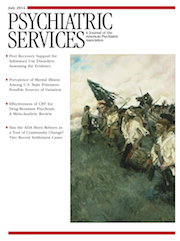Stigma, Race, and Culture
To the Editor: I congratulate Dr. Sirey and colleagues (1) on highlighting the impact of stigma on referral for mental health assessment in their report in the April issue. However, I would like to discuss the fact that they also report differences in the level of stigma and referral rates in two racial groups: African Americans and Caucasians. The racial comparison may say more about the state of medical research into diversity than shed light on useful insights into differences within populations.
Despite clear scientific reasoning to the contrary, race is often used interchangeably with ethnicity or culture (2). But these variables are different and measure different things. Inappropriate use can make it difficult to understand what findings mean and what can be done about them (3). Race is characterized by a handful of phenotypic features. Modern genetic techniques have undermined the biological usefulness of the concept (2). Indeed, in some places the term “race” is rarely used, and “racialized groups” is used instead (4). The color of someone’s skin continues to be of significance because of the social processes that make it important (2,3).
Culture is a social construct characterized by the behavior and attitudes of a social group. It is linked to the history, upbringing, and individual choices of people in that group. It can change over time and is very difficult to measure (2,3). Ethnicity is the most used but arguably the most difficult variable to standardize. It is characterized by a sense of belonging—a place of origin—but also by the social pressures on a group (2,3).
Better science is produced by making sure that the variable that is chosen fits the hypotheses under study. For instance, if differences are considered biological, then groups based on race may be more useful than cultural groups. If mechanisms that produce differences are social, then culture or ethnicity may be more useful than race. If racism is considered important, then comparing racial groups may be most appropriate.
The study by Dr. Sirey and colleagues reported differences between African Americans and Caucasians in rates of anticipated stigma. An outcome of such research might be the development of interventions focused on the African-American population. However, a closer look at the data reveals that the majority of people in both racial groups endorsed high anticipated levels of stigma about mental health problems—68% of the African-American group and 53% of the Caucasian group. The level of stigma is more likely related to culture than to the color of your skin. If the researchers had based their group variables on cultural hypotheses about possible causes for differences, then they may have decided to try to identify sociocultural factors that may have been involved. They could have defined their groups and made comparisons based on cultural variables. This would have put them in a better position to understand which members of their sample (across their racial groups) were at highest risk for anticipated stigma and delay in referral for mental health assessments. And this would be more useful information for identifying why high anticipated stigma occurs and what can be done about it. It could have also helped to better identify risk factors for high anticipated stigma that could alert clinicians to be more vigilant.
1 : Race stigma and mental health referrals among clients of aging services who screened positive for depression. Psychiatric Services 65:537–540, 2014Link, Google Scholar
2 : Race, ethnicity, culture, and science. British Medical Journal 309:286–287, 1994Crossref, Medline, Google Scholar
3 : Describing race, ethnicity, and culture in medical research. BMJ 312:1054, 1996Crossref, Medline, Google Scholar
4 (eds): Race, Racialization and Anti-Racism in Canada and Beyond. Toronto, University of Toronto Press, 2007Crossref, Google Scholar



